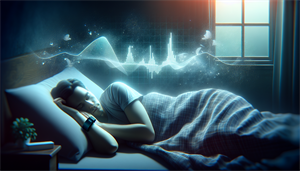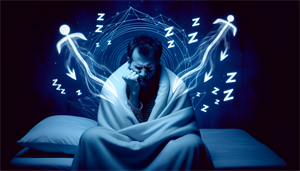Sleep apnea is a significant sleep disorder that can lead to serious health complications if not detected and managed timely.
As technology advances, wearable tech devices like Fitbit have become increasingly popular for monitoring various health indicators, including signs of sleep apnea. In this article, we will explore the question, “what does sleep apnea look like on Fitbit?”
Let’s delve into the world of sleep apnea and Fitbit’s capabilities in detecting its signs.
Key Takeaways
-
Fitbit devices can aid in sleep apnea detection by tracking sleep stages, oxygen saturation, and detecting snoring, although they are not FDA-approved for diagnosing the condition.
-
Devices such as the Fitbit Sense, Versa series, and Charge series offer various sleep tracking features, but with different capabilities; for example, the Sense includes snore detection, while the Charge series lacks a microphone.
-
Fitbit data can be valuable for managing sleep apnea by sharing it with healthcare providers, tracking progress over time, and making lifestyle adjustments, but this should complement rather than replace medical advice and treatment.
Identifying Sleep Apnea Signs on Fitbit
![]()
Sleep apnea, particularly obstructive sleep apnea, is characterized by interrupted breathing, multiple nightly wake-ups, and lack of restful sleep. Identifying these symptoms is significant because they can lead to serious health complications such as high blood pressure, stroke, and cardiovascular disease.
Although Fitbit devices are not officially approved for diagnosing sleep apnea, they can aid in recognizing potential symptoms by tracking sleep patterns and quality.
Interrupted Breathing
Fitbit devices, such as the Fitbit Sense, detect interrupted breathing by monitoring an individual’s oxygen levels during the night and identifying instances when blood oxygen saturation levels fluctuate. While these devices are not recognized as an approved sleep apnea test by the FDA, they can offer insights into sleep patterns that could potentially identify sleep apnea.
Multiple Nightly Wake-Ups
Another significant sign of sleep apnea is multiple nightly wake-ups. Fitbit identifies these wake-ups by monitoring heart rate variability (HRV) and tracking the time spent awake or restless during sleep.
There is a correlation between sleep apnea and nighttime awakenings, making sleep data essential in the potential to diagnose sleep apnea through a sleep study that monitors the patient throughout the night.
Lack of Restful Sleep
A lack of restful sleep, characterized by sleep disorder symptoms such as:
-
being a restless sleeper, affecting sleep quality
-
inadequate REM sleep
-
alterations in deep sleep breathing
-
experiencing irritability or crankiness
can also be indicative of sleep apnea. Fitbit defines restful sleep based on heart rate, the duration of wakefulness or restlessness, and the various sleep stages, which can assist in identifying such signs.
Fitbit's Role in Sleep Apnea Detection and Monitoring

Fitbit devices significantly contribute to sleep apnea detection and monitoring by measuring heart rate, tracking oxygen saturation, and detecting snoring. Fitbit devices, by tracking heart rate variability and heart rate throughout sleep, can help in recognizing sleep apnea by noticing changes that might suggest breathing disruptions during sleep.
Heart Rate Monitoring
![]()
Fitbit devices estimate the heart rate during sleep by analyzing data from both awake and asleep periods. It utilizes a combination of movement and heart rate metrics to assist in identifying sleep patterns and estimating sleep stages.
Studies indicate that there is a strong connection between sleep apnea and heart rate for many individuals. Variations or irregularities in heart rate during sleep could potentially signal the existence of sleep apnea.
Oxygen Saturation Tracking
Fitbit devices like the Versa 3 and Sense come with a SpO2 sensor that gauges blood oxygen levels throughout sleep, providing helpful observations for possibly recognizing sleep apnea. Monitoring oxygen saturation is significant in detecting sleep apnea as it helps in evaluating the cardiorespiratory health of individuals.
Snore Detection

Fitbit’s smartwatches are equipped with a built-in microphone that monitors loud snoring events during the night. These events are logged and analyzed using features such as a snore report, which can assist in identifying potential sleep disorders, including sleep apnea, by highlighting snoring patterns that may be linked to the condition.
The usage of the Snore Report feature on Fitbit does lead to heightened battery consumption.
Comparing Fitbit Devices for Sleep Apnea Tracking
![]()
Fitbit offers different devices with unique features and capabilities for sleep apnea tracking. These include the Fitbit Sense, Versa series, and Charge series. Each of these devices offers different features and capabilities, providing users with a variety of options based on their preferences and requirements.
Fitbit Sense
The Fitbit Sense offers advanced attributes for tracking sleep apnea, such as sleep stages graph and the Snore & Noise Detect feature, which are not present in all Fitbit models.
The Snore & Noise Detect feature in Fitbit Sense serves to identify snoring and ambient noise, which are potential indicators of sleep apnea.
Fitbit Versa Series
The Fitbit Versa series has the capability to detect indications of sleep apnea, although it does not have official approval for diagnosing sleep-disordered breathing. The Fitbit Versa series, particularly the Fitbit Sense and Fitbit Versa 3, is capable of monitoring sleep stages and identifying snoring through the utilization of the Snore & Noise Detect feature, available as part of Fitbit Premium.
Fitbit Charge Series
The Fitbit Charge series provides the ability to track a range of metrics such as heart rate, movement, and sleep stages, in order to generate a comprehensive sleep score. However, the absence of a microphone does not hinder the Fitbit Charge series’ capacity to track sleep stages, as it utilizes movement and heart-rate patterns to approximate sleep stages.
How to Use Fitbit Data for Sleep Apnea Management
Managing sleep apnea effectively involves:
-
Detection and monitoring
-
Understanding the data
-
Sharing the data with healthcare providers
-
Track sleep apnea progress over time
-
Making necessary lifestyle adjustments to manage the condition better.
Sharing Data with Healthcare Providers
The data collected by Fitbit can provide valuable insights into your sleep patterns and potential signs of sleep apnea. Sharing this data with healthcare providers can aid in the diagnosis and treatment of sleep apnea.
However, it should be noted that this data should not replace medical advice but should be used in conjunction with professional medical consultation and treatment.
Tracking Progress Over Time
Fitbit devices allow users to track their progress over time, providing them with valuable insights into their sleep patterns and potential improvements in their condition. By observing sleep patterns and identifying indicators of sleep apnea, such as frequent awakenings, irregular breathing, or low oxygen levels, users can monitor the effectiveness of their treatments and make necessary adjustments.
Adjusting Lifestyle Habits
Fitbit data can assist users in identifying lifestyle habits that may contribute to sleep apnea, thereby enabling them to detect sleep apnea and make necessary adjustments to improve their condition.
Recommended lifestyle changes to potentially improve sleep apnea include modifying nutrition habits, increasing physical activity, practicing mindfulness, and improving sleep hygiene/environment.
Fitbit vs. Other Sleep Trackers for Sleep Apnea Detection
While Fitbit provides a range of features for sleep apnea tracking, other sleep trackers such as Apple Watch and Withings ScanWatch also offer sleep apnea detection features. Each of these devices has its own advantages and disadvantages, and the choice between them would largely depend on the user’s preferences and specific needs.
Apple Watch
The Apple Watch, although not specifically intended for sleep apnea detection, can offer insights into sleep patterns that could be valuable for comprehending the user’s overall sleep health. However, it’s worth mentioning that the Apple Watch does not carry FDA approval for detecting sleep apnea.
Withings ScanWatch
The Withings ScanWatch comes with features like a medical-grade SpO2 sensor, an ECG function, and sleep tracking capabilities, which can be helpful in recognizing potential sleep apnea interruptions. However, it does not currently have well-defined sleep apnea monitoring capabilities, and its watch hands may occasionally obstruct the screen.
Summary
In conclusion, Fitbit provides a valuable tool for tracking and monitoring potential signs of sleep apnea. With features such as heart rate monitoring, oxygen saturation tracking, and snore detection, Fitbit devices can offer insights into sleep patterns that can aid in the detection and management of sleep apnea. However, it’s important to note that while Fitbit can provide valuable data, it should not replace professional medical advice and diagnosis.
Frequently Asked Questions
Can you tell if you have sleep apnea from a Fitbit?
No, Fitbit can provide data on sleep patterns but is not capable of diagnosing sleep apnea. The device is not a medical device and is not regulated by the FDA.
What does sleep apnea look like on a fitness tracker?
Sleep apnea can appear on a fitness tracker as a decrease in heart rate and blood oxygen levels during sleep. If these levels stay low for extended periods, it may indicate sleep apnea, and you should consult a doctor for a treatment plan.
What does a good Fitbit sleep score look like?
A good Fitbit sleep score ranges from 90 to 100 (Excellent) and 80 to 89 (Good), with most people scoring between 72 and 83. Fair scores range from 60 to 79, and poor scores are less than 60.
Can Fitbit data replace medical advice?
No, Fitbit data should not be used as a substitute for medical advice and guidance from a healthcare professional.
Can Fitbit data be shared with healthcare providers?
Yes, Fitbit data can be shared with healthcare providers by sending the report directly to your healthcare professional.


